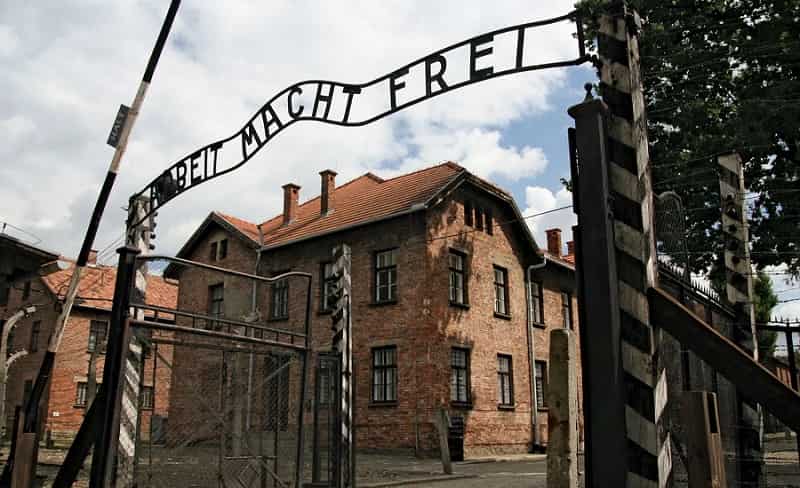Also known as the Auschwitz-Birkenau Memorial and Museum, The Auschwitz Museum is situated on the grounds of the largest Nazi concentration camp. The campsite is situated near a small town called Auschwitz where over 1.5 million people were bought and executed from the year 1940-1945. The museum focuses on educating the visitors about its history and the life of prisoners who spent their years at the concentration camp. You can get a chance to witness thousands of objects and artifacts which belong to the people and the guards living in these camps.
The Auschwitz museum is home to over ten thousand artifacts such as shoes, luggage, kitchen utensils, prostheses, and orthoses, and also over 4,100 works of art. Additionally, the Auschwitz museum also has the belongings of the SS Garrison who was responsible for being cruel to thousands of prisoners and for mass extermination. The museum is recognized as a UNESCO World Heritage Site and attracts millions of visitors annually from around the world.

History of the Auschwitz Concentration Camp
- Started in 1940 by the Germans, Auschwitz became of the largest nazi concentration and death camps by 1942.
- It is said that more than a million people have lost their lives at Auschwitz.
- The concentration camp was originally built as a detention center for citizens of Poland who were arrested by the Germans.
- These citizens included teachers, civil servants, politicians, and priests.
- The concentration camps were divided into Auschwitz I , Auschwitz II-Birkenau, and Auschwitz III Monowitz and subcamps.
Auschwitz I
Auschwitz I was the original site of the concentration camp and was home to over 16000 prisoners. This was also home to the administrative office of the SS garrison. You can look at the gas chamber, Barrack 10 where doctors would carry out medical experiments on the prisoners, and also the crematorium.
Auschwitz II-Birkenau
Auschwitz II-Birkenau was started in 1941 and is located 72 km from Krakow. This is the largest facility that served as the extermination center for Jews once it was opened in 1942. It contained a number of crematoriums and gas chambers. Birkenau was the location where the majority of Auschwitz Concentration Camp victims died.
Auschwitz III Monowitz and subcamps.
Started in 1942. this was the largest subcamp of Auschwitz and was created for the slave laborers who were working in the IG Farben. This subcamp also became the headquarters of the industrial subcamps and 1670 prisoners were murdered here.
Highlights
- Go on a guided tour of the Auschwitz Museum and learn the horrors and history of the largest nazi concentration camp.
- You can go on a guided tour in 4 languages, English, Italian, German, or Spanish.
- You can also get a chance to visit the barracks and gas chambers where you can experience the reminders of the Holocaust.
- Learn more about the prisoners and witness the objects and artifacts which they used during 1940-194
Auschwitz Birkenau Entrances
Auschwitz has two main entrances, Auschwitz I or the main camp, and the Auschwitz II Birkenau.
The Main Entrance to Auschwitz I
Just outside of Oswiecim, on National Route 933, is the entrance to the major camp, Auschwitz I. Since Auschwitz I’s opening, the entrance gate has been engraved with the phrase “Arbeit Macht Frei,” which translates to “work makes (one) free.”
Hell’s Gate Auschwitz II Birkenau
From the loading rail ramp, you can see Birkenau’s main entrance, also called as Auschwitz/Birkenau Hell’s Gate. Everyone who enters the main camp also enters the Auschwitz II Birkenau camp through hell’s entrance gate. The difference between Auschwitz II’s main entrance from the main camp is 3 kms.
Best way to reach Auschwitz Museum
Train: The nearest railway station is in Oswiecim. You can also get direct trains from Krakow tp Oswiecim’s central station and the whole train journey will take around 2 hours. Once you reach the railway station the Auschwitz Museum is just 2 km away and you can take a cab or taxi to reach the destination.
Bus: The nearest bus stop to the Auschwitz Museum is the Oswiecim Muzeum bus stop. You can take a bus at the MDA station from Krakow and it will take you 2 hours to reach your destination.
Car: One of the most easiest ways to reach the Auschwitz Museum is by car. The distance from Krakow to Auschwitz is 68 km and you can reach in 1 hour and 30 minutes,
Location and timings:
Locations: Address: Więźniów Oświęcimia 20, 32-603 Oświęcim, Poland
Timings:
December: 8:00 AM – 2:00 PM
January and November: 8:00 AM – 3:00 PM
February: 8:00 AM – 4:00 PM
March, October: 8:00 AM – 5:00 PM
April, May & September: 8:00 AM – 6:00 PM
June, July & August: 8:00 AM – 7:00 PM


